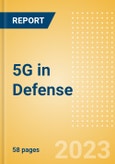The emergence of 5G communications networks in the commercial telecoms sector, players and end users throughout the defense industry are assessing the technology's numerous potential applications. 5G networks provide increased data transmission speed and capacity which will be critical to enabling the digital transformation envisioned by military strategists worldwide. By combining 5G with other emerging technologies such as artificial intelligence, virtual reality and defense cloud networking, armed forces have the potential to revolutionize real-time command and control on the battlefields of the 21st century. However, 5G networks also present a new raft of information security challenges, driving a greater need for cybersecurity throughout all domains of operations in the defense sector.
- This report provides an overview of the defense-oriented 5G market, outlines advances in technology and key programs, and provides insight into current procurement and research trends
Key Highlights
- Studies of emerging technological trends and their broader impact on the defense market
- Analysis of the various defense related 5G projects currently under development, as well cross-industry research initiatives which could impact the future applications of these technologies
Scope
- The key defense challenges that forces and defense sector suppliers face are covered
- The investment opportunities for armed forces, suppliers, and institutional investors, across the whole 5G value chain are covered
- Highlights from the range different 5G connectivity research and development programs currently being undertaken by various military organizations and defense companies
Reasons to Buy
- Determine potential investment companies based on trend analysis and market projections
- Gaining an understanding of the market challenges and opportunities surrounding the 5G in defense theme
- Understanding how spending on 5G technology will fit into the overall market and which spending areas are being prioritized.
Table of Contents
- Executive summary
- Players
- Technology briefing
5G Applications - Enabling the multi-domain operations doctrine
- Trends
- Technology Trends
- Macroeconomic trends
- Regulatory trends
- Industry analysis
- Mergers and acquisitions
- Patent trends
- Hiring trends
- Case Studies
- Timeline
- Value Chain
5G Software & Network Operators
- Defense Applications
- Companies
- Leaders
- Disruptors
- Sector Scorecards
- Aerospace, defense and security scorecard
- Glossary
- Further reading about our Thematic Research methodology
- About the Publisher
- Contact the Publisher
- Leading players in the 5G in defense theme
- Key components of the 5G mobile network architecture
- China’s 5G subscriptions will dwarf those of all other countries by 2027
- North America will lead the way in 5G penetration
- Mobile 5G service revenues will increase to $720.8 billion by 2027, up from $141.2 billion in 2021
- China drives growth in patent applications, but most of the top assignees are US companies
- Companies across sectors have been increasingly mentioning 5G in their filings between 2019 and 2022
- Usage scenarios of IMT for 2020 and beyond
- Sector scorecard - Companies
- Sector scorecard - Thematic
- Sector scorecard - Valuation
- Sector scorecard - Risk
- Technology trends
- Macroeconomic trends
- Regulatory trends
- Mergers, acquisitions and joint ventures
- Companies: Leaders
- Companies: Disruptors
- Glossary
- Furthur Reading
Companies Mentioned (Partial List)
A selection of companies mentioned in this report includes, but is not limited to:
- AT&T
- China Mobile
- Ericsson
- Fujitsu
- Huawei Technologies
- Leonardo
- Lockheed Martin
- Nokia
- Northrop Grumman
- Qualcomm
- Saab
- Samsung Electronics
- SK Telecom
- Softbank
- T-Mobile US
- Verizon
- ZTE
- Apple
- British Telecom
- China Telecom
- China Unicom
- Deutsche Telekom
- Intel
- KDDI
- Korea Telecom
- LG Uplus
- NTT DoCoMo
- Telefonica
- Vodafone








